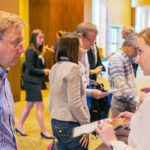Collaborative robots are seeing exponential rise in use. “This trend is a perfect example of the so-called fourth industrial revolution or Industry 4.0 … a term defined by chairman of the World Economic Forum Klaus Schwab. It’s blurring lines between digital, physical, and biological spheres,” said Jonas Proeger of Trinamic Motion Control.
Some of these robotic designs aren’t much larger than a human limb, which means they have demanding electronics requirements, noted Proeger. Everything must be more cost efficient, because the targeted quantities are much higher … and yet at the same time, these motion components must be exceptionally compact.

“So there is no space for six servo-drive boxes besides the robot … or large control cabinet, either. Everything has to be in the arm — ideally, right there in the robot joints,” said Proeger.
Case in point: Elmo Motion Control EtherCAT Gold servo drives mount directly into robot joints on the Siasun Collaborative Robot Coworker. Two small Gold SOLO GUITAR drives power two base-joint motors that support robot’s mechanical structure. Being able to drive the motors with current to 50 A (and peak current to 100 A) lets the drives deliver the power needed for quick moves. Five other Gold SOLO WHISTLE drives run five other joints on the robot.
Frameless torque motors are leading choice for robotic joints
Besides needing compact electronics, collaborative robots also need compact motors for their actuation. “In the area of collaborative robots, we see more OEMs interested in frameless torque motors. They’re also looking for small-diameter motors with high power density,” agreed Allied Motion Technologies systems engineer Jeffrey Shearer.

Similar applications with these design requirements include hip-assist and medical robotics for physical therapy, Shearer added.
“We gained early experience with small robots such as these when developing the drives for the KUKA YouBot back in 2010,” said Proeger. “Going forward, we predict that collaborative robots will drive more demand for affordable and accessible functional safety components … because they are working together with human operators, so must be safe — but aren’t developed by safety specialists. So we predict increasing demand for proven building blocks that make certified functional safety more accessible for developers.”
Others agree on the safety to accompany these designs.
Consider today’s car plants, in which humans and robots are segregated on the plant floor … so for example, machines moving car-frame sections will automatically stop if workers cross set barriers. “In the not-too-distant future, advances in technologies such as machine vision and machine learning will let ever-larger cobots work with humans in these settings,” said Brendan O’Dowd of Analog Devices.
Of course, increasingly capable cobots to handle big loads are strong and more capable of inflicting damage that smaller cobots — and that magnifies the need for safety. But addressing safety for these big cobots can’t be by simple exclusion, noted O’Dowd.
“Cobots tailored to ISO standards certainly satisfy safety requirements, but new functionalities always demand that industry develop new guidelines. For example, cobots can have set speed limits; staying below these limits makes the cobots safe to humans. Key to this functionality are new time-of-flight sensors that include camera systems, RADAR, and LiDAR,” added O’Dowd.
For more details on frameless motors in LiDAR systems, read this story from Lin Engineering. For more information on collaborative robots, visit this library of articles on therobotreport.com.






Leave a Reply
You must be logged in to post a comment.